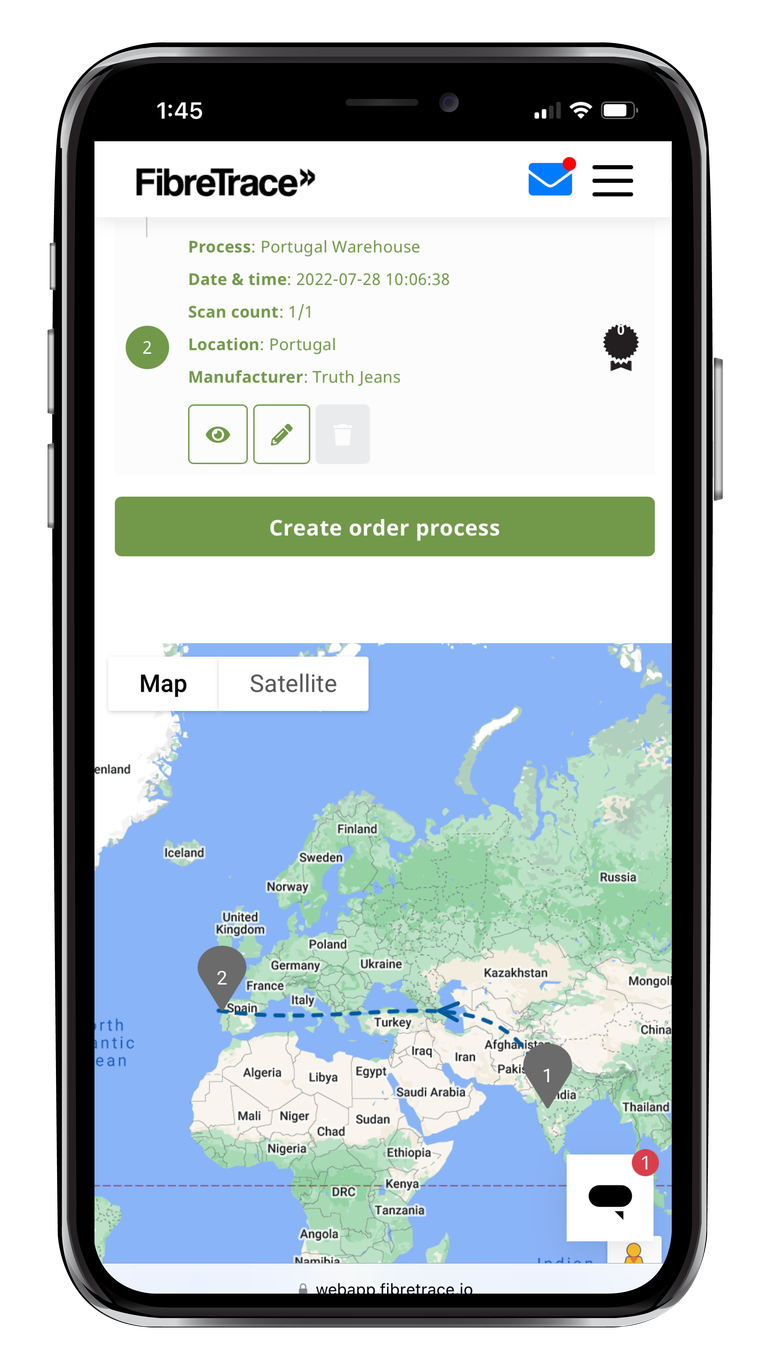
More than 50 percent of fashion decision-makers say traceability will be a top-five enabler to reduce emissions in their supply chains, according to BoF and McKinsey & Co’s State of Fashion: Technology report. It is an essential tool to meet consumer and shareholder expectations around improving sustainability endeavours.
Technology platform FibreTrace offers real-time verification of products as they move through the global supply chain.
FibreTrace works with brands, manufacturers, farmers and raw fibre producers to connect the supply chain. The company launched its first core product, FibreTrace Verified, in partnership with fashion brand Reformation in March 2021. Today, the technology is used by 10 brands, including Reformation and 7 For All Mankind, and over 60 suppliers of cotton, recycled polyester, viscose, and soon, wool and leather.
FibreTrace Verified connects digital traceability with physical technology, applying non-toxic, luminescent pigments onto raw fibres at their source. The pigment is indestructible throughout the processing cycle, and can be read and tracked at every stage of the supply chain through a hardware device. Each audit is recorded on the blockchain and provides AI-powered insights for businesses. FibreTrace marked cotton is consequentially permissible with US customs and import regulations.
Although fashion companies are expected to ramp up their investments in technological solutions, the State of Fashion: Technology report revealed that supply chain transparency and traceability solutions lag behind virtual sampling, capacity planning and virtual fabric libraries as an investment priority.
As a solution, FibreTrace has developed a second product this year, FibreTrace Mapped, a digital-only solution that maps the global textile supply chain from fibre to retail, and took the decision to offer brands and manufacturers free access to the tool to democratise the ability to increase supply chain transparency.
After one year, free access will be capped at 500 digital audits a year. Any company operating under that unit amount will continue to receive free access, while larger companies will be charged an annual rate of US$2,640.
Now, BoF sits down with FibreTrace CEO Shannon Mercer to better understand how the technology works, the data and analytics available to companies, and the next steps for FibreTrace technologies.
Why is traceability and transparency important in the textile industry?
SM: Changes to consumer behaviour and legislation over the last 5 to 10 years have been a big driver for the increasing prevalence of traceability and transparency. There is now a regulatory framework in Europe and the US, turning traceability and transparency from a nice-to-have to a must-have.
What technological solutions does FibreTrace offer?
SM: We have two solutions — FibreTrace Verified and FibreTrace Mapped.
FibreTrace Mapped is our new digital chain of custody that tracks and maps product certificates, purchase orders, shipping documents and the like, and then uses blockchain to record those processes to provide an irrefutable ledger of what occurred in the supply chain. FibreTrace Mapped also provides the brand the opportunity to share their supply chain details with the end consumer.
We are releasing version one of Mapped for free to the global industry. Over the next 12 to 24 months, we will continue to enhance the platform with product templates, reporting tools and enhanced functionality.
FibreTrace Verified uses a patented physical tracing system to audit and verify fibre as it moves through the supply chain. Each fibre has a different application, and each fibre type has a unique signature. For example, US cotton would have a different signature than Australian cotton, and recycled polyester would have a different signature than virgin polyester. Then we use proprietary handheld scanners that act as digital auditors to physically verify the fibre in real time and confirm its provenance and that there is no unauthorised blending.
How is the technology shared across the supply chain?
SM: Using FibreTrace Mapped is as simple as registering on the platform and uploading your company details and products. Once you have created your product, you invite the next person in the supply chain on the platform, who then receives a notification of a private trace order, and then accepts that order. I think of it like a relay race in handing the baton to the next person until the product is fully mapped out.
How can brand partners effectively leverage your products and services?
SM: When we look at adoption, it is difficult because there are a number of factors that overlay customers joining — there is the perceived cost, implementation, onboarding, data security, all of these things.
When we split it to FibreTrace Verified and FibreTrace Mapped, we have put the onus on the brand to make a decision on where they require a digital chain of custody and where they require physical traceability. That allows the adoption of traceability into the sector and then allows them the opportunity to choose the suppliers they partner with, allowing them to scale from the platform.
The more brands, manufacturers and suppliers embrace traceability, the greater the pressure will be on all players to have an industry-wide standard for transparency.
We allow users to first adopt the platform digitally through FibreTrace Mapped, where they can increase transparency across the supply chain. They are then given the opportunity to add physical fibre verification with FibreTrace Verified.
Why did you offer the FibreTrace Mapped service for free?
SM: The industry talks about traceability, but when we look at the adoption at scale across any brand or fibre, it is not moving fast enough. The more brands, manufacturers and suppliers embrace traceability, the greater the pressure will be on all players to have an industry-wide standard for transparency.
Offering our service for free takes away the barriers to entry. Once we can get people on the platform and show them the benefits of utilising it, it makes adoption across sectors a lot easier. It is a big cost, obviously, but it is not just a marketing gimmick — we are trying to make a difference. This is why we have a continual free option beyond the first year of introduction, making it plausible for small to medium sized enterprises to take the first step to transparency.

From a manufacturing perspective, we are starting to see preferential treatment for brands that are adopting traceability technology, because it makes it easier to build out their supply chains. So, there is definitely an opportunity for farms and manufacturers to engage more deeply with brands, be able to differentiate themselves from others and drive a premium
What are AI-powered insights and how can they benefit businesses?
SM: When data comes in, you can start to compare information and pull insights that can better inform your business.
The first version of FibreTrace Mapped comes with simple reporting mechanisms where you can see the global map of where your supply chain partners are, timelines of digital audits matched to data additions or certificate uploads, and list views of products in the supply chain.
For version two, which will be released in the next 12 months, we will add product templates and advanced reporting functionalities. These will be built with input from our participating brand and manufacturing partners.
One of the misconceptions is that traceability is a cost to a business. I totally disagree with that. From a compliance perspective, as these systems are adopted, they negate the need for some types of certifications because technology takes over.
What is next for FibreTrace?
SM: This year we are working on bringing leather, wool, linen, hemp and responsible down to market with FibreTrace Verified in the hopes of delivering physical traceability across all manmade and natural fibres.
From a technology perspective, we continue to support the B2B part but also built out the consumer component, so brands can educate consumers and show them the work they are doing around traceability and transparency. That is a key component for us.
With greenwashing, there is a lack of consumer trust now about what is actually printed on the label — is it real or is it not? So, the drive of these transparency solutions and having traceability, particularly connecting physical and digital, allows brands to drive consumer trust. Therefore, I would argue, that traceability is not a cost to the sector at all. It is actually an opportunity.
This is a sponsored feature paid for by FibreTrace as part of a BoF partnership.

